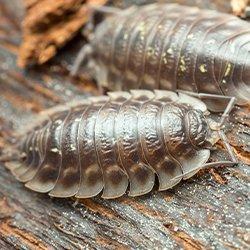If you are a gardener or homeowner in Springfield or anywhere throughout Western Massachusetts, you may at times find yourself dealing with an unwelcome visitor. Sow bugs, which are also called woodlice, can be a nuisance in your home and destructive to your garden. They are often confused for their more well-known counterpart, the pill bug, which is often called the “roly-poly.” Despite their names, pill bugs and sow bugs aren’t technically bugs at all. They are crustaceans, and despite being the only crustaceans that spend their entire life on land, they are more closely related to a lobster than an ant or termite.
Sow Bugs Vs. Pill Bugs
Sow bugs and pill bugs closely resemble each other, but you can tell them apart if you know the similarities and differences:
- Both sow bugs and pill bugs range from ¼ - ½ inch long.
- Both vary in color from brown to black, with slate grey being the most common color.
Both have seven pairs of legs. - Sow bugs have two tail-like appendages that pill bugs do not.
- Pill bugs can roll up into a hard ball when they are threatened, while sow bugs cannot.
Crustaceans Need Water
While they have adapted to live on land, sow bugs need water to survive. Because they are particularly vulnerable to water loss, sow bugs are mostly active at night and tend to remain in areas with high moisture content. These areas include:
- Under trash, rocks, logs, and boards that retain moisture.
- In the moist soil found in flowerpots and gardens.
- Under piles of decaying organic material like grass clippings and mulch.
If sow bugs do not have moist conditions like the ones described above, they usually die within two to three days.
The Issue With Sow Bugs
If you are dealing with a sow bug infestation, you can take heart in knowing they are mostly harmless and pose no real threat to people, pets, or property. They don’t spread diseases, bite, or sting, and they won’t destroy your home the way other pests will. These small crustaceans feed primarily on decaying organic material like grass clippings and mulch.
While they are just a nuisance indoors, sow bugs cause their biggest problems in your garden. In a garden, sow bugs will feed on new foliage, as well as the roots and stems of young plants, which can cause serious damage. They will also eat the skin off fruits or vegetables on the ground, causing them to be deformed.
How To Prevent Sow Bugs
While harmless to pets and people, sow bugs can still be a major annoyance if an infestation occurs in your home. There are a few basic steps that can help prevent sow bugs from taking over your home and garden. Since they thrive in moist areas, eliminating these environments can eliminate the presence of sow bugs around your property. Some steps you can take to prevent sow bugs include:
- Remove piles of organic material like grass clippings or leaves. They provide a food source and a moist habitat for sow bugs.
- Keep firewood stored off the ground and away from your home and garden.
- Make sure basements, attics, and crawl spaces have adequate ventilation to prevent the build-up of moisture.
- Ensure rainwater is being diverted away from your home with clear and properly functioning gutters and downspouts.
If these steps don’t work, and the problem becomes too big for you to handle on your own, contact the professionals at American Pest Solutions to help you deal with your sow bug issues.

